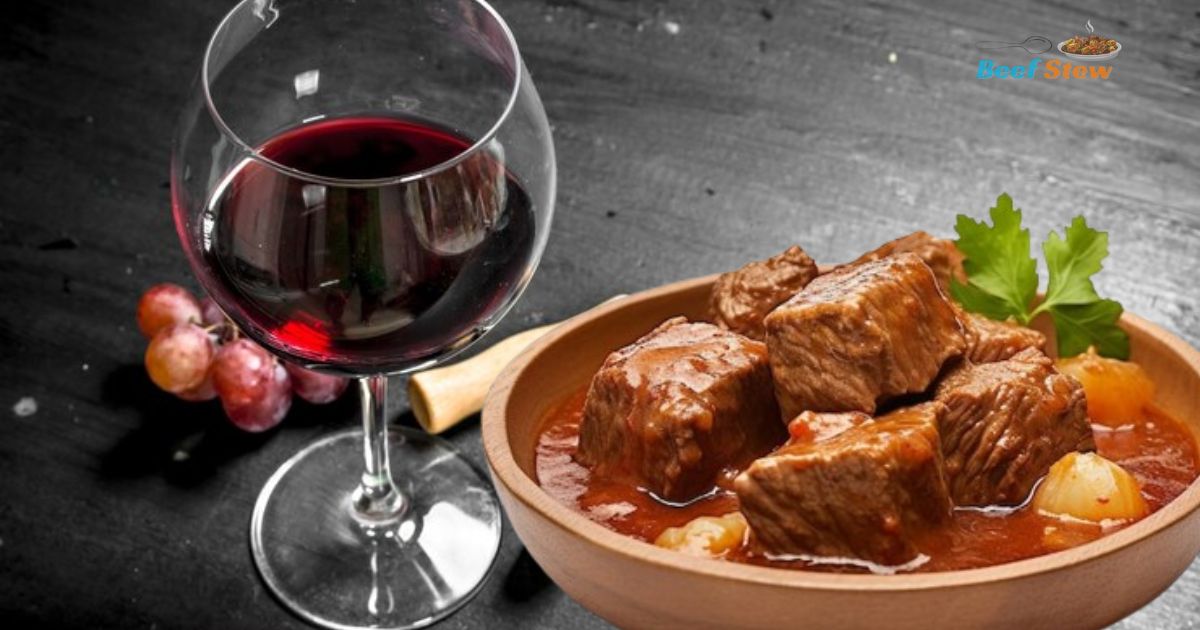Beef Stew is a comforting classic where tender beef and vegetables combine in a flavorful broth, creating a hearty and satisfying dish. This is a classic comfort food that many people in America enjoy during the colder months.
Adding red wine to beef stew elevates its flavor profile, adding depth of flavor and complexity to the dish. Beef stew with red wine offers a delicious twist on a traditional recipe, bringing out the natural richness of the beef and enhancing the overall dining experience.
Red wine not only enhances the flavor of beef stew but also adds a subtle sweetness and acidity that balance the richness of the meat. It is a popular choice for those who want to add a sophisticated touch to their homemade beef stew recipes.
Beef stew with red wine recipe

If you are cooking at home and need a simple and very easy beef stew with red wine recipe, here is one shared—simple and to the point.
Beef stew with red wine recipe Ingredients:
– 1/4 cup all-purpose flour
– 1/2 teaspoon black pepper
– 3 teaspoons oil
– 1 1/2 pounds beef stew meat, cut into small pieces
– 1/4 cup vinegar
– 1/2 cup red wine
– 4 cups beef broth
– 2 large bay leaves
– 1 medium onion, chopped
– 1/2 pound baby carrots
– 2 pounds potatoes, cut into small pieces
– Salt and black pepper to taste
Beef stew with red wine recipe Directions:

1. In a bowl, combine flour and black pepper. Add the beef and coat well. Heat 3 teaspoons of oil in a large pot. Cook the beef until browned on all sides, turning occasionally.
2. Remove the beef from the pot and add vinegar and red wine. Cook over medium-high heat, scraping the pan to loosen any browned bits. Add beef, beef broth, and bay leaves. Bring to a boil, then reduce to a simmer.
3. Cover and cook until beef is tender, about 1½ hours, skimming broth from time to time. Add onions and carrots, simmer covered for 10 minutes. Add potatoes and simmer until vegetables are tender, about 30 minutes more. Add broth or water if stew is dry. Season with salt and pepper, to taste. Ladle into four bowls and serve.
Your delicious beef stew with red wine is ready!
Is Red Wine Good in Beef Stew?
Red wine can be a really wonderful addition to beef stew. Its rich and complex flavors complement the beef and vegetables, adding depth and richness to the dish.
When simmered with beef and other ingredients, red wine helps tenderize the meat and infuses the stew with a unique flavor that sets it apart from traditional recipes.
Many chefs and home cooks swear by adding red wine to their beef stew recipes. The acidity in the wine helps break down the fibers in the meat, resulting in a more tender and flavorful dish.
The alcohol in the wine evaporates during cooking, leaving a subtle but distinctive flavor that enhances the overall flavor of the stew. So, the next time you’re making beef stew, consider adding a splash of red wine for a delicious twist!
What is the secret to tender beef stew?
Achieving a tender beef stew requires attention to a few key factors. One of the secrets to tender beef stew lies in choosing the right cut of beef. Choose tougher cuts, like chuck or round, which have more connective tissue.
This tissue breaks down during the slow cooking process, resulting in melt-in-your-mouth tender meat perfect for stews. Marinating beef before cooking can help tenderize it further. Acidic ingredients like vinegar or wine, along with herbs and spices, can do wonders for breaking down muscle fibers and enhancing flavor.
Another secret to tender beef stew is to cook it low and slow. Slow cooking allows the collagen in the connective tissues to gradually break down, resulting in tender and flavorful meat.
This method also allows the flavors in the stew to meld together, creating a rich and flavorful dish. So, remember to be patient and give your beef stew the time it needs to cook to perfection!
Can you put too much red wine in the stew?
Yes, it is possible to pour too much red wine into a stew. While red wine can enhance the flavor of a stew, adding too much can overpower the dish and make it taste too acidic or bitter. The key is to use red wine in moderation, as a little goes a long way in adding depth and complexity to a stew. When adding red wine to a stew, it’s important to taste as you go and adjust the amount accordingly.
Start with a small amount, such as half a cup, and gradually add more if needed. Remember that the flavors will concentrate as the stew cooks, so what may seem a little off-putting at first may become more pronounced over time. By practicing moderation and achieving a harmonious balance, you can ensure that your stew maintains its delicious flavor profile while incorporating the essence of red wine without overpowering it.
What gives beef stew the best flavor?
The best flavor in beef stew often comes from a combination of ingredients and cooking methods. While the beef itself provides a hearty base, the addition of aromatic vegetables like onions, carrots, and celery enhances the overall flavor.
Using beef broth as the cooking liquid adds depth, while herbs and spices like thyme, bay leaves, and garlic fill the stew with savory notes. However, what really elevates the flavor of beef stew is the slow cooking process.
Allowing the stew to simmer slowly and slowly for hours helps the flavors meld together, resulting in a rich and flavorful dish bursting with savory goodness.
FAQ’s
Can I make beef stew with red wine if I don’t drink alcohol?
Yes, you can replace the red wine with beef broth or a mixture of vinegar and water for the same depth of flavor.
How long does it take to cook beef stew with red wine?
Generally, beef stew with red wine takes about 2 to 3 hours to cook on low heat for tender and flavorful results.
Can I freeze leftover beef stew with red wine?
Yes, you can freeze beef stew with red wine in an airtight container for up to 3 months ready to eat.
Conclusion
Beef stew with red wine is a delightful twist on classic comfort food. Its rich flavors and soft texture make it a favorite dish for many. Whether enjoyed on a cool evening or as a hearty meal for the family, this recipe never fails to satisfy. But you might be wondering what other ingredients can elevate this dish. Explore your creativity and share your ideas below.











